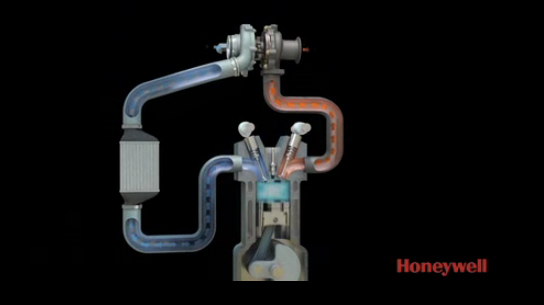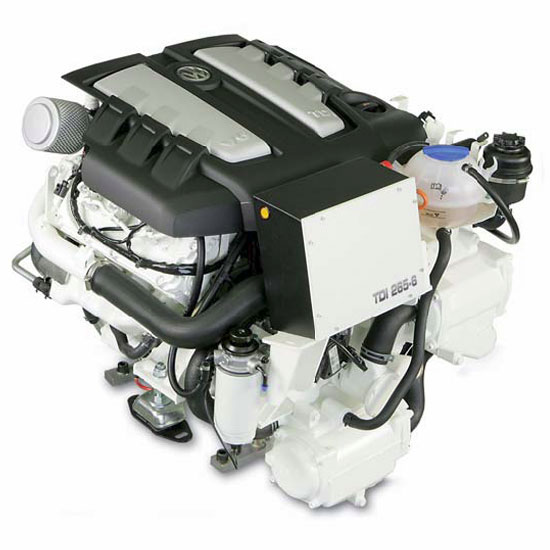Marine Diesel Engines
Diesel engines have been powering boats for a long time. How do they differ from gas engines? What are the trade-offs? Read on.
The marine diesel engine is certainly nothing new; its roots go back to the early 1900s when they were used to power ships and submarines. Early diesel engines were considered a logical replacement for steam engines.
Marine Diesel Basics
- Combustion from high cylinder pressure and heat, not spark
- Better energy extraction from fuel than gas engines
- Heavier than similar-power gasoline engines
- More expensive than equivalent gasoline engines
- Turbocharged diesel models are lighter

The Yanmar 6LY 400/440 is a modern turbocharged marine diesel in the company’s Powerboat Engines series. Photo courtesy of Yanmar.
Of all the commonly used engines available today, the diesel has the highest thermal efficiency, meaning its ability to extract energy from its fuel. This of course equates to overall engine efficiency. This very fact probably explains why, according to a UK survey, 50% of the cars sold in the European Union are diesel-powered: Fuel prices are extremely high in the EU compared the US.
One gallon of low-sulfur diesel fuel has 113% of the energy of one gallon of gasoline. For biodiesel at a 20% blend, diesel still beats gasoline, packing 109% of gasoline’s energy.
Why are diesels so much more thermally efficient than their gasoline fueled counterparts? The answer lies in the differences between how diesels and gasoline engines operate. Gasoline engines are sometimes referred to as “spark-ignition” engines, as opposed to diesels, which are “compression-ignition” engines. This description identifies one of the primary differences between gasoline and diesel engines.
Instead of using a spark to ignite fuel, a diesel engine creates enough pressure in its cylinders to heat the fuel to the point of ignition, with the atomized diesel fuel getting injected directly into each cylinder at just the right time. The auto-ignition temperature for diesel fuel is about 600°F, so the pressure within each cylinder must be high enough to produce that temperature to ignite the fuel and begin the combustion process. In practice, the actual temperatures achieved will be more in the 700°F-plus range.

This illustration shows the sequence in what’s referred to as the “four-stroke cycle” in a gasoline engine. In a diesel four-stroke cycle, the spark plug is replaced with a high-pressure fuel injector that sprays atomized fuel into the cylinder at a specified time just between the compression and the power stroke.
Another advantage of the diesel engine is introduced with these facts: No spark plugs or ignition system are needed on the diesel, eliminating one of the maintenance and potential reliability issues long associated with gasoline-fueled engines. There are trade-offs however. To achieve the pressure needed to generate enough heat to auto-ignite the diesel fuel, diesel engines must run at much higher compression ratios than gasoline engines, on the order of 15:1 to over 20:1. vs. 8:1 to around 10:1 for gasoline-fueled engines. This means that the diesel engine needs to be built much stronger than a gasoline engine to withstand the extreme pressures involved. Unfortunately, this added strength most often equates to larger, heavier engine parts and the weight that goes with these heavy-duty components.
The Weight Issue
The disparity in weight is changing as technology moves ahead though. A check of current models from Yanmar and Mercruiser is telling. Using 350 HP as a basis, a current Yanmar V-8 diesel weighs in at 960 lbs. A 350 HP Mercruiser gasoline engine weighs in at 862 lbs. That’s only a 98-lb. difference. Application of stronger but lighter materials and improvements in overall efficiency can account for enhanced power-to-weight ratios. Turbocharging, for example, improves what is known in the engine world as “volumetric efficiency.” Additionally, some of the overall efficiency loss in any engine goes out the exhaust. This is regained somewhat by using exhaust gas to power the turbocharger.

Turbochargers add power to an engine by making use of its exhaust gases. That extra power enables engine makers to reduce engine size and weight, and increase fuel efficiency. Click the image above for a video showing how a turbo works. Video courtesy of Honeywell.
Engines without superchargers or turbochargers will always run at less than 100% volumetric efficiency, whereas a supercharged or (more commonly today) turbocharged engine will run at over 100% efficiency in terms of the amount of air that gets squeezed into the combustion chamber on each intake stroke. This increased air volume, matched with more precise fuel injection and enhanced atomization of the fuel in today’s extremely high pressure common-rail injection systems, enables the engine makers to get more power and reduced emissions out of their engines. So, with enhanced power-to-weight ratios, smaller engines can be used to achieve the same levels of power that 20 years ago meant a much higher disparity in weight between a gas vs. diesel engine.
The Reliability Issue
If you are, in effect, squeezing more power out of a modern diesel engine, how is its long-term reliability impacted? Does the added stress reduce the longevity of the engine? It’s a tough question to answer directly, because actual use habits vary considerably among boat owners, and this factor will contribute heavily to an engine’s long-term reliability. A look at some data provided by John Deere Co. may provide some insight here. They categorize their engines by use habits, as shown in this chart:
Marine Engine Ratings Definitions
- M1: For propulsion applications that may operate up to 24 hours a day at uninterrupted full power. These applications typically operate over 3,000 hours / year.
- M2: For propulsion applications that may utilize full power up to 16 out of each 24 hours of operation. These applications typically operate at full power up to 65% of the time and accumulate as many as 3,000 hours / year
- M3: For propulsion applications that may utilize full power up to 4 out of each 12 hours of operation. These applications typically operate at full power up to 35% of the time and accumulate as many as 2,000 hours / year
- M4: For propulsion applications that may utilize full power up to 1 out of each 12 hours of operation. These applications typically operate at full power up to 15% of the time and accumulate as many as 800 hours / year
- M5: For propulsion applications that may utilize full power up to 30 min. out of each 6 hours of operation. These applications typically operate at full power up to 8% of the time and accumulate as many as 300 hours / year
Keep in mind that John Deere is known more for commercial and industrial applications than for recreational engines, but these ratings give an idea of what kinds of service life their diesels are designed for. Most recreational diesels would probably fall within Deere’s M4 or M5 rating definitions.
All marine engine suppliers should be able to provide similar ratings for a given engine, via their “duty-cycle” rating classification system. Their terminology may vary, but all manufacturers use the same determinants to classify each rating: load factor, typical operational hours per year, and typical full-power operation hours. These ratings should be applied according to how the vessel operates, its type and design, and the anticipated power demands of the engine.

Sailboat owners often replace their original gasoline engines or older diesels with smaller, lighter modern diesels. Photo courtesy of Oldport Marine Services.
In heavy-duty commercial situations there will likely be some trade-offs between lighter, turbocharged diesel engines and heavier “naturally aspirated” diesels without turbos in terms of potential long-term engine life. That said, average recreational boaters aren’t ever likely to know the difference — they just don’t use their boats frequently enough to accumulate the hours needed for this to be a significant concern.
Now that you know a bit about the basic differences between diesel and gasoline engines, you can dig deeper into your research with Boat Engines: Choosing Gas or Diesel.
Then, if you decide that diesel is the way to go for your new boat or for repowering, read Choosing the Right Marine Diesel.












